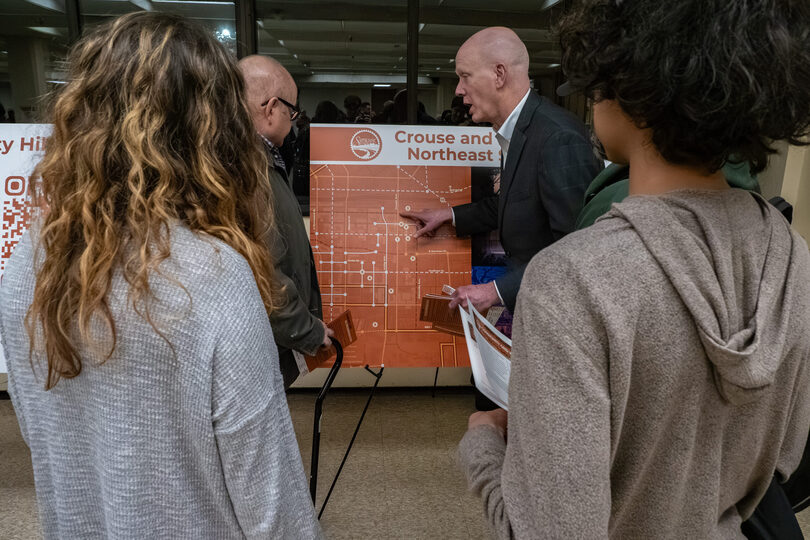City of Syracuse holds second Community Grid Vision Plan open house

Lars Jendruschewitz | Asst. Photo Editor
Greg Loh, Chief Policy Officer at the Office of the Mayor, explains the new I-81 Community Grid Vision Plan to attendees at a city open house. The discussion included a feedback session where residents expressed their questions and concerns.
Get the latest Syracuse news delivered right to your inbox.
Subscribe to our newsletter here.
Mayor Ben Walsh spoke at a city of Syracuse informational open house Wednesday evening about its Community Grid Vision Plan, which it announced Feb. 21. The plan is a guide for city and state officials to follow as the community grid is developed.
The event, held at Lincoln Middle School, was the second of two open houses this week — the first held at STEAM at Dr. King Elementary School Tuesday night.
The Community Grid Vision Plan is a drafted proposal of over 60 suggested quality-of-life improvements in Syracuse, including biking and pedestrian routes, more efficient buses and public transportation as well as improved streets — both existing and new streets created by the I-81 Viaduct Project and community grid, according to the plan.
The plan has yet to be approved, unlike the I-81 Community Grid, which the New York State Department of Transportation announced its approval of in April 2019. Rather, the plan is a long-term “living document” being drafted of possible changes to the city, which could be years or even decades away, said Joshua Frank, an urban design and town planner at Dover, Kohl & Partners — a Florida-based town planning firm. The city paid Dover, Kohl & Partners $500,000 of American Rescue Plan funds to create the vision plan, according to WRVO.
“In order to have a productive conversation about this vision plan, it’s critical that you accept the reality that the community grid plan is happening,” Walsh said. “Whether you like it or not — I don’t say that in an antagonistic way — it’s just the reality that we are in right now. The issue has been debated, it’s been litigated.”
Frank, who led the open house, spoke for a half-hour detailing each proposed change and opened a Q&A session with community members.
In the University Hill neighborhood, the vision plan looks to implement biking and pedestrian paths down Irving Avenue, Van Buren Street and Henry Street to connect Oakwood Cemetery to Almond Street, the latter of which is viewed as a potentially transformative street for the city, Frank said.
The organizers behind the vision plan envision Almond Street as a boulevard comparable to Commonwealth Avenue in Boston with expanded investment in walkability, storefronts and buildings with affordable housing, Frank said.
“Almond Street, we think, has the potential to be one of the best streets in North America. I’m not being hyperbolic when I say that,” Frank said.
The plan also includes a proposal to connect Irving Avenue, Forestry Drive and Sims Drive to the Smart 1 Bus Rapid Transit project along the east side of Syracuse University’s campus. The BRT project aims to prioritize buses throughout Syracuse, with bus-only traffic lanes and streetlights that allow buses to cross before passenger vehicles, Frank said.
Though the vision plan is not primarily focused on the University Hill neighborhood, some student attendees said they were worried about how the plan will displace Syracuse residents in the South Side neighborhood.

Cole Ross | Digital Design Editor
Dana Fries, a senior at SUNY ESF, said she is “apprehensively” in favor of the plan, as she worries about how the project will impact Syracuse’s South Side neighborhood.
“(Frank was) saying that there were a couple of different options for the South Side (and) that some things are gonna be a challenge. I’m just worried about the trust of those people, because they have been displaced before,” Fries said.
The open houses were held on both the South Side and North Side of the city, with Tuesday’s open house at Dr. King Elementary School in the South Side neighborhood and Wednesday’s discussion in the north, Walsh said.
“We did intentionally come here on the northern side of the city, because that is an area that has received less attention, I think, over the course of the debate and discussion on I-81,” he said.
Other longtime Syracuse citizens also expressed their concerns with the project, citing how it may impact low-income housing.
Judy Jerome, a retired librarian, SU graduate and resident of the University Hill neighborhood, described herself as an “advocate” for people who reside in the neighborhoods that I-81 originally displaced.
“My biggest concern is that they will not make adequate housing for the people that need housing in that area,” she said. “Years ago, when I first heard it proposed, I thought ‘What a dumb idea.’ I (then) read, I educated myself and the more I read about it, the more I saw what was being done in other cities. I thought — ‘I’m an advocate.’”
The vision plan is still in the draft stage, Frank reiterated throughout the open house. Once the plan is finalized after receiving feedback from Syracuse residents, the Dover, Kohl & Partners team will submit a strategic action plan to the city — a “shopping list” of every idea, Frank said. The city will then have a detailed proposal of reviewed feedback for future construction projects.
“Our best job right now is to get as close as we can to what everyone can agree on is the future of what they want Syracuse to be when they grow up,” Frank said.





